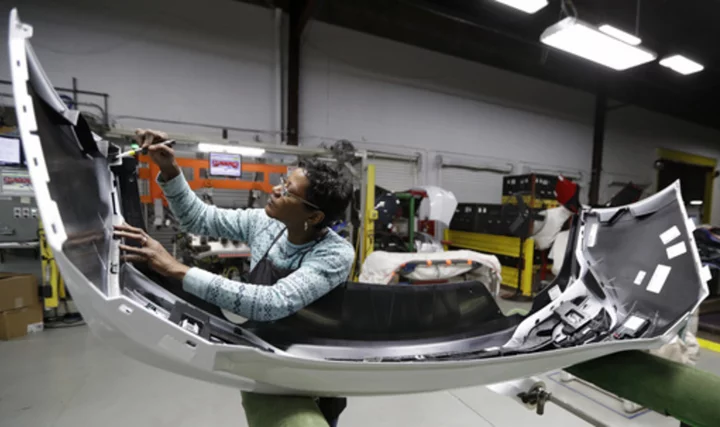WASHINGTON (AP) — To President Donald Trump, America’s trade relationship with Mexico was intolerable. He seethed over the U.S. trade deficit and the shuttered factories in America's heartland. “No longer,’’ he vowed six years ago, “are we going to allow other countries to break the rules, to steal our jobs and drain our wealth.”
So Trump pressured Mexico and Canada to replace their mutual pact with one more to his liking. After a couple of years of negotiations, he got what he wanted. Out was the North American Free Trade Agreement. In was the U.S.-Mexico-Canada Agreement.
The USMCA, which Trump hailed as “the fairest, most balanced and beneficial trade agreement we have ever signed," will reach its third anniversary Saturday.
The trade pact hasn't proved to be the economic bonanza Trump boasted it would be. It couldn’t have been, given that trade makes up less than a third of America's $26 trillion economy.
Yet while the the deal's overall impact has been slight, it has nevertheless been helping workers on the ground. It’s just that the beneficiaries have so far been mostly in Mexico. Novel provisions of the pact have enhanced the ability of long-exploited Mexican workers to form unions and secure better wages and working conditions.
Trade officials and experts predict, though, that the benefits will also flow, in time, to U.S. workers, who no longer must compete with severely underpaid Mexican laborers without real bargaining power.
“U.S. workers win when workers in other countries have the same rights,’’ said Cathy Feingold, director of the AFL-CIO’s international department.
Thea Lee, a deputy undersecretary at the U.S. Labor Department, suggested that the pact and Mexico's reforms haven't been around long enough to yield measurable help to American workers yet. “We’re going to see the positive results first for Mexican workers because Mexico is undergoing a massive, comprehensive, ambitious labor market reform," she said.
In some ways, the USMCA as a whole has fallen short of Trump’s promises.
Take the trade deficit with Mexico. Despite Trump’s insistence that the USMCA would pull more manufacturing back to the United States, the gap between what America sells and what it buys from Mexico keeps widening: It has surged from the $64 billion gap in 2016 that so irritated Trump to a record $139 billion last year.
The former president also predicted that exports of U.S. auto parts to Mexico would rise by $23 billion. They have increased since 2020 — but only by about $8 billion.
“I don’t expect that we’re ever going to be able to say that (the USMCA) accomplished very much,’’ said Alan Dierdorff, a professor emeritus of economics and public policy at the University of Michigan. “I don’t think it hurt much. But I don’t think it helped much.’’
Trump said the pact would create 76,000 auto industry jobs. Since January 2020, vehicle and parts manufacturers have actually added nearly 90,000 jobs. And North American commerce has flourished. America’s trade with Canada and Mexico — exports plus imports — reached a record $1.78 trillion last year. That was up 27% from 2019 and was above a 20% gain in trade with China over the same period.
But it’s hard to tease out which economic gains can be credited to the USMCA and which happened for a variety of unrelated reasons. That is especially true in light of the unusual economic tumult of the past three years: A devastating pandemic, followed by severe labor shortages and supply chain backlogs and a resurgence of rampant inflation.
Also complicating any effort to calculate the USMCA’s impact is President Joe Biden’s own aggressive efforts to rejuvenate American industry with trillions of dollars in infrastructure spending and subsidies.
For all of Trump’s bombast, the USMCA actually left in place much of the pact it replaced. NAFTA erased most of the import taxes that the United States, Mexico and Canada imposed on each other’s goods. It created a duty-free regional bloc meant to compete with the European Union and China. That structure remains mostly in place.
“It’s still pretty much the same as NAFTA,” Dierdorff said.
Still, some substantive changes have occurred. When NAFTA took effect in 1994, for instance, the internet, e-commerce and smartphones weren't part of everyday business. The new pact updated North American trade rules for the digital age.
The USMCA, for instance, bars the United States, Mexico and Canada from hitting each other with import taxes on music, software, games and other products sold electronically; allows the cross-border use of electronic signatures and authentication; and protects companies from having to disclose in-house source codes and algorithms.
Given how it modernized North American trade, the “USMCA is a marked improvement,’’ said Neil Herrington, the U.S. Chamber of Commerce’s senior vice president for the Americas.
Perhaps the most consequential changes the pact wrought were designed to reverse one of NAFTA’s unhappy byproducts for Americans: The old deal incentivized companies to close factories in the United States, ship production to lower-wage Mexico, then export goods back into the United States — duty free.
The USMCA sought to make it harder for autos and auto parts to enjoy tariff-free treatment. To qualify, 75% of a car and its parts had to come from North America, up from 62.5% under NAFTA. That meant more content had to come from higher-wage North American workers, not imported cheaply from China or elsewhere. And at least 40% of vehicles would have to originate in places where workers earn at least $16 an hour — that is, the United States and Canada, not Mexico.
But those so-called automotive rules of origin stumbled out of the gate. Enforcement was delayed as customs officials faced supply chain backlogs at the height of the COVID crisis.
“Border officials were worried about clearing cargo in ports and getting rid of congestion,’’ said Daniel Ujczo, senior counsel at the law firm Thompson Hine in Columbus, Ohio. “They didn’t have a ton of time to deal with USMCA.’’’
Even after the auto rules took effect, the United States was slapped down for the way it tried to enforce them. A USMCA trade court, in a case brought by Mexico and Canada, found that Washington was applying the rules more strictly than was allowed.
The United States has achieved more success in using the deal to pressure Mexican employers to comply with their country’s labor reforms. Workers there can now vote freely and fairly on joining unions, approving contracts and choosing union leaders. In the past, pro-company unions in Mexico signed contracts behind workers’ backs. Strikes were rare, wages stayed low and union leaders got rich.
The USMCA armed the United States, Mexican workers and union activists with a new weapon: The “Rapid Response Labor Mechanism." This allows the U.S. government to crack down on individual factories in Mexico — by, for example, suspending tariff exemptions for their products – if they violate Mexican labor law.
“We took a lot of the key parts of (Mexico’s) labor reform, and we baked them directly into the trade agreement,’’ said Josh Kagan, assistant U.S. trade representative for labor affairs. “We’re holding Mexico to actually implement this labor reform they’ve undertaken.’’
So far, the United States has used the mechanism 11 times to demand corrections of labor law violations. Mexico has so far cooperated, by sending law enforcement and labor inspectors to guard ballot boxes in new votes that independent unions have mostly won.
Under pressure from a U.S. complaint, Mexican officials and observers oversaw a union vote in which the old union was thrown out. The new union won the right to negotiate — and an 8.5% wage increase, plus bonuses.
“If workers had tried a similar organizing effort before, “they would have fired us immediately," said Manuel Carpio, who works at a General Motors plant in Silao, in the state of Guanajuato.
Still, it isn't a perfect process, said Julia Quiñonez, who organized an independent union at a U.S.-owned auto parts plant, VU Manufacturing, in the city of Piedras Negras, Coahuila, across from Eagle Pass, Texas. The old union joined with the company to try to bar the new union. The two sides are still struggling.
“We have heard about other cases where the companies have respected the process and agreed to corrective plans," Quiñonez said. "But the VU case has been plagued by a lot of deceit, corruption and frustration.’’
One problem, Quiñonez said, is that cases tend to be kicked back to the same Mexican courts and authorities that should have enforced the law in the first place.
“The obstacles we are facing are the normal resistance you might expect in a system that has been operating for at least 80 years,” she said.
The worker provisions in the USMCA were strengthened in negotiations between Trump’s trade team and congressional Democrats. Working on those talks was Katherine Tai, then the chief trade counsel on the House Ways and Means Committee and now Biden’s top trade negotiator.
The Biden administration says it views the worker provisions in the USMCA as a model for future trade deals that seek to benefit workers, not just companies that want to expand their exports.
“I don’t think anybody knew how the Rapid Response Mechanism process would play out,’’ the Labor Department’s Lee said. “But people have found that it’s working as anticipated and as hoped.’’
____
Stevenson reported from Mexico City, Krisher from Detroit.









